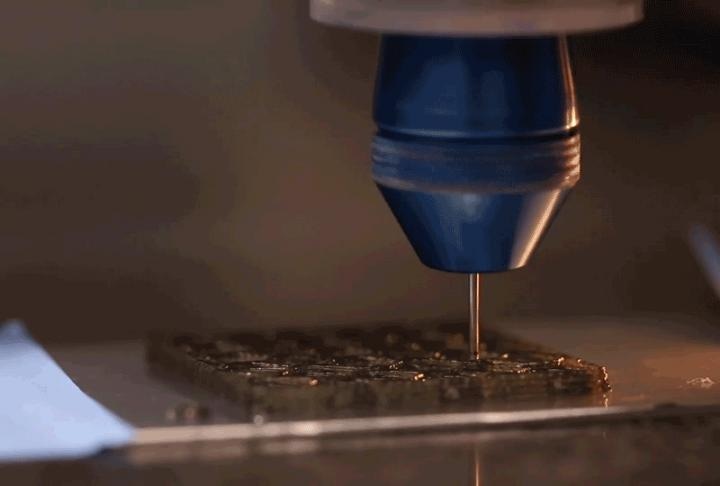Jan 16 2018
Nature has created attractive composite materials - wood, teeth, bone and shells, for instance - that integrate light weight and density, with necessary mechanical properties such as strength, stiffness and damage tolerance.
 Rotational 3-D printing precisely choreographs the speed and rotation of a 3-D printer nozzle to program the arrangement of embedded fibers in polymer matrices. This is achieved by equipping a rotational printhead system with a stepper motor to guide the angular velocity of the rotating nozzle as the ink is extruded. (Image credit: Brett Compton/SEAS)
Rotational 3-D printing precisely choreographs the speed and rotation of a 3-D printer nozzle to program the arrangement of embedded fibers in polymer matrices. This is achieved by equipping a rotational printhead system with a stepper motor to guide the angular velocity of the rotating nozzle as the ink is extruded. (Image credit: Brett Compton/SEAS)
Since ancient civilizations first joined mud and straw together to form bricks, people have fabricated engineered composites of increasing complexity and performance. However, replicating the extraordinary mechanical properties and multifaceted microstructures found in nature has been difficult.
Currently, researchers at the Harvard John A. Paulson School of Engineering and Applied Sciences (SEAS) have showed a novel 3D printing technique that yields exceptional control of the arrangement of short fibers embedded in polymer matrices. They used this additive manufacturing method to program fiber orientation within epoxy composites in specified locations, enabling the formation of structural materials that are enhanced for stiffness, strength and damage tolerance.
Their technique, referred to as "rotational 3D printing," could have wide ranging applications. Given the modular nature of their ink designs, many varied filler and matrix combinations can be applied to customize optical, electrical or thermal properties of the printed objects.
"Being able to locally control fiber orientation within engineered composites has been a grand challenge," said the senior author of the study, Jennifer A. Lewis, Hansjorg Wyss Professor of Biologically Inspired Engineering at Harvard SEAS. "We can now pattern materials in a hierarchical manner, akin to the way that nature builds." Lewis is also a Core Faculty Member of the Wyss Institute for Biologically Inspired Engineering at Harvard.
The research, published in the journal PNAS, was carried out in the Lewis lab at Harvard. Collaborators included then-postdoctoral fellows Brett Compton (now Assistant Professor in Mechanical Engineering at the University of Tennessee, Knoxville) and Jordan Raney (now Assistant Professor of Mechanical Engineering and Applied Mechanics at the University of Pennsylvania); and visiting PhD student Jochen Mueller from Prof. Kristina Shea's lab at ETH Zurich.
The key to their method is to precisely choreograph the rotation and speed of a 3D printer nozzle to program the set-up of embedded fibers in polymer matrices. This is accomplished by fitting a rotational printhead system with a stepper motor to guide the angular velocity of the rotating nozzle as the ink is extruded.
Rotational 3D printing can be used to achieve optimal, or near optimal, fiber arrangements at every location in the printed part, resulting in higher strength and stiffness with less material. Rather than using magnetic or electric fields to orient fibers, we control the flow of the viscous ink itself to impart the desired fiber orientation.
Brett Compton
Compton observed that the team's nozzle concept could be applied on any material extrusion printing technique, from direct ink writing, to fused filament fabrication, to large-scale thermoplastic additive manufacturing and with any filler material, from carbon and glass fibers to metallic or ceramic platelets and whiskers.
The method allows for the 3D printing of engineered materials that can be spatially programmed to attain specific performance goals. For instance, the orientation of the fibers can be locally enhanced to boost the damage tolerance at locations that would be expected to experience the maximum stress during loading, hardening potential failure points.
One of the exciting things about this work is that it offers a new avenue to produce complex microstructures, and to controllably vary the microstructure from region to region. More control over structure means more control over the resulting properties, which vastly expands the design space that can be exploited to optimize properties further.
Jordan Raney
"Biological composite materials often have remarkable mechanical properties: high stiffness and strength per unit weight and high toughness. One of the outstanding challenges of designing engineering materials inspired by biological composites is control of fiber orientation at small length scales and at the local level," said Lorna J. Gibson, Professor of Materials Science and Engineering at MIT, who was not involved in the research. "This remarkable paper from the Lewis group demonstrates a way of doing just that. This represents a huge leap forward in the design of bio-inspired composites."
The Harvard Office of Technology Development has protected the intellectual property relating to this project.
Previously, Lewis has performed groundbreaking research in the 3D printing of tissue constructs with vasculature, lithium-ion microbatteries and the first autonomous, entirely soft robot.
Other contributors to the paper include Thomas Ober from Harvard SEAS and Kristina Shea from ETH Zurich.
The research was supported by the Office of Naval Research and GETTYLAB.